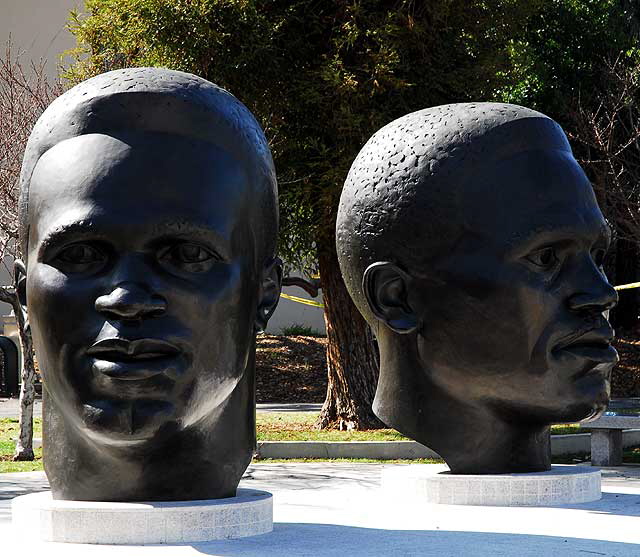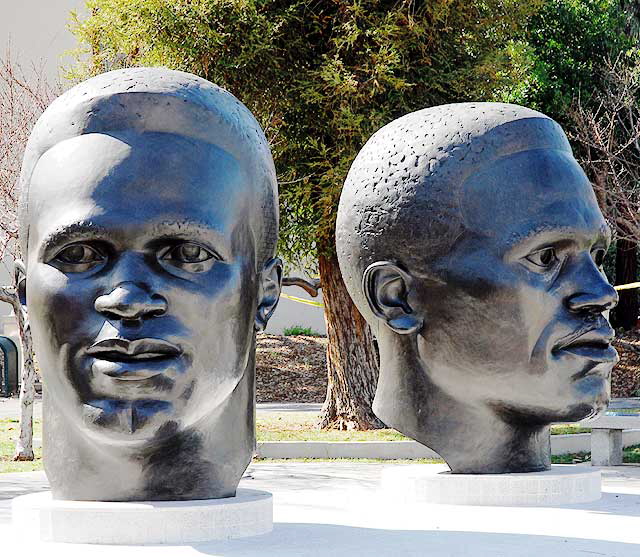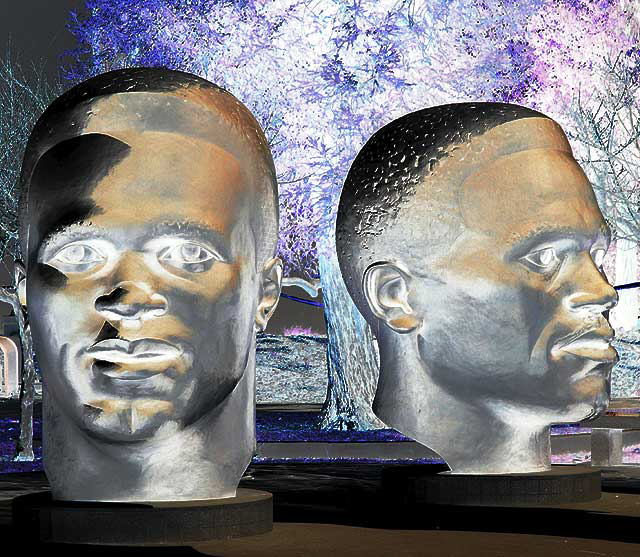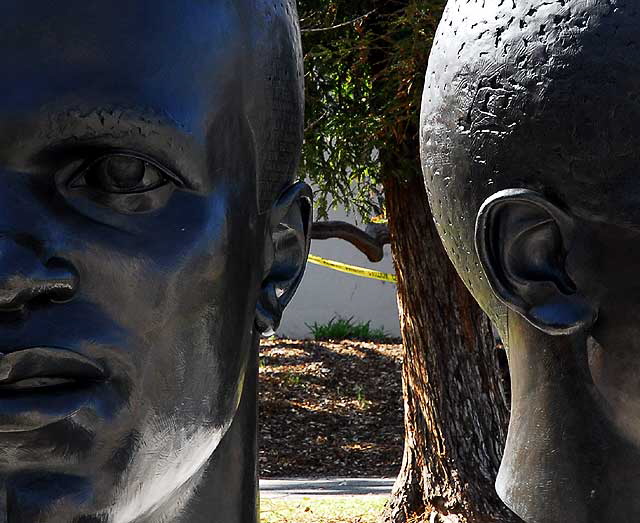|
|
|||||||||||||||||||||||||||||||||||||||||||||||||||
|
|
|||||||||||||||||||||||||||||||||||||||||||||||||||
|
|
|||||||||||||||||||||||||||||||||||||||||||||||||||
|
|
||||||||||||||||||||
|
Home (latest issue) | Recent Photography | Image Archives | Guest Photography | The International Desk | About This Site | Search This Site | Just Above Sunset Commentary |
|
Friday, February 20, 2009 – Bronze Brothers The bronze portrait sculptures commemorating the lives of two brothers, Jackie and Mack Robinson, Garfield Avenue, north of Union Street, across the street from Pasadena City Hall – |
||
 |
|
This was dedicated on November 6, 1997 – close to where these two grew up. Everyone knows Jackie Robinson – star athlete at Pasadena City College and UCLA, and then, in 1947, the first African-American in major league baseball. His older brother, Mack, qualified for the Olympic team and, in Berlin in 1936, ran second in the 200 meters to Jesse Owens, finishing in 21.1 seconds as Owens ran an Olympic-record 20.7 seconds for one of his four gold medals. The memorial is the work of Ralph Helmick, in collaboration with Stuart Schechter and John Outterbridge. |
||
 |
||
 |
||
 |
||
|
Regarding Mack Robinson: He was one of America's best sprinters of the 1930's, but Matthew Mack Robinson hardly seemed destined for athletic feats. While Robinson was in high school in Pasadena, wrote David Wallechinsky, the Olympic historian, ''coaches did not consider him athletic material and made his mother sign a statement absolving them of blame if his heart was damaged.'' Even when he showed formidable talents while in junior college, it seemed that Robinson would not even make it to the trials for the 1936 United States Olympic track team. ''No one paid an athlete's way in those days,'' Robinson once recalled. ''The trials were in New York, and Pasadena Junior College didn't have any money to send me. And I didn't have a dime to make a trip like that on my own.'' He got there because Pasadena businessmen raised $150 each for him and a teammate. Robinson qualified for the Olympic team and, in Berlin, he ran second in the 200 meters to Owens, finishing in 21.1 seconds as Owens ran an Olympic-record 20.7 seconds for one of his four gold medals. ''Jesse got the coaching, I didn't,'' he said long afterward. ''I saw his television program, about his return to Berlin. He said that he and the coaches had studied the styles of every runner. That was true. They studied me, too.'' In the Olympics, Robinson ran in the same spikes he wore all season in junior college. ''It's not too bad to be second best in the world at what you're doing, no matter what it is,'' he said of his Olympic silver medal. ''It means that only one other person in the world was better than you. That makes you better than an awful lot of people.'' But when Robinson returned to Pasadena after the Olympics, he felt unappreciated. ''If anybody in Pasadena was proud for me, other than my family and close friends,'' he said, ''they never showed it. I was totally ignored. The only time I was noticed was when somebody asked me during an assembly at school if I'd race against a horse.'' From the Los Angeles Times, November 7, 1997: Characterizing Jackie and Mack Robinson as "rebels against racism," Mayor Chris Holden on Thursday helped unveil busts of the two Pasadena natives in a ceremony at City Hall. The two nine-foot bronze busts were created by the artistic team of Ralph Helmick, Stu Schecter and John Outterbridge. The project was led by the Robinson Memorial Foundation, which solicited $325,000 in donations, including $100,000 from the city. The Robinson brothers grew up in Pasadena in the 1920s and started on athletic teams for John Muir High School and Pasadena City College. Mack Robinson, who was hospitalized and unable to attend the ceremony, was known for his silver medal-winning performance in the 200-meter dash at the 1936 Olympics. The late Jackie Robinson achieved fame for breaking the color barrier in baseball. Both men were praised Thursday as leaders in the fight for civil rights. Sam Mardian, 78, of Phoenix, a friend of Jackie Robinson since the fourth grade, said the busts are a fitting tribute. "Jackie Robinson was one of the greatest athletes of all time, but his contributions went well beyond athletics," Mardian said. "He helped make civil rights and the work of Martin Luther King possible." Baseball great Don Newcombe said the memorial is overdue but welcome. "This helps me believe that people can make good things happen… With this [memorial] it feels like the city is making amends for past mistakes," he said. Perhaps. |
|
|
Home (latest issue) | Recent Photography | Image Archives | Guest Photography | The International Desk | About This Site | Search This Site | Just Above Sunset Commentary |
|
All text and photos, unless otherwise noted, Copyright © 2003, 2004, 2005, 2006, 2007, 2008, 2009 - Alan M. Pavlik |
